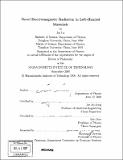Novel electromagnetic radiation in Left-Handed materials
Author(s)
Lu, Jie, Ph. D. Massachusetts Institute of Technology
DownloadFull printable version (15.41Mb)
Alternative title
Novel electromagnetic radiation in LHMs
Other Contributors
Massachusetts Institute of Technology. Dept. of Physics.
Advisor
Jin Au Kong and Min Chen.
Terms of use
Metadata
Show full item recordAbstract
In this thesis, Cerenkov radiation of a moving charged particle inside a Left-Handed material (LHM) is studied through both theory and numerical simulations. A LHM is a material whose permittivity and permeability have negative real parts. In the analysis of this thesis, the general theory of Cerenkov radiation was first studied for the unbounded regions filled with LHM. The physical meanings of different Green's functions are discussed, and finally the second kind of Hankel function is determined to represent the special properties of Cerenkov radiation: forward incoming phase and backward outgoing power, which satisfies both momentum and energy conservation. The effects of the dispersion and dissipation of both permittivity and permeability are also investigated. The results show that both forward and backward radiated waves can co-exist at different frequencies. When the dissipation is reduced, the directions of forward and backward radiation are close to 900 with respect to the particle's moving direction. When the LHM is bounded, a waveguide can be formed. Depending upon the configuration and the relative dielectric constants of the surrounding normal material (we call them RHM in comparison with LHM), a surface wave can be formed. (cont.) When a LHM is used as the filling material of a metallic waveguide, the radiation at some frequencies can be enhanced when a surface wave is excited. This enhancement can make the total radiated power in the waveguide larger than the radiation when the LHM is unbounded. Furthermore, using the same surface wave property, the decay of the radiation by a free space channel can be compensated when the channel is surrounded by a LHM. The wave of Cerenkov radiation is a TM wave. In order to have a homogeneous response, the LHM structure should have at least two dimensional isotropic negative permittivity and one dimensional negative permeability. A new LHM design was proposed in this thesis. We have demonstrated that this design shows several advantages in comparison with present published designs through reflection and transmission simulations, and TM (TE) prism simulations. For the unit cell's dimension of 5mm, a LHM band is observed between 6GHz and 7GHz for TM wave incidence. We use an antenna array to model a traveling current source, which can represent a single frequency component of a particle motion. The simulations show that our design can bend the radiation inside the structure. (cont.) In order to observe the signal in the far field, we propose to use prism shaped LHM structures around the antenna array, by which, the difference between the angles of the forward radiation and backward radiation can be further amplified. These results can be a basis for a future experimental verification of backward radiation of the antenna arrays in a LHM. Besides, two effects of the surface wave for the effective LHM slab are also investigated. The results show that the surface wave actually determines the focusing ability of a LHM slab. When the mismatch between the slab and the surrounding area becomes small, those evanescent waves, whose wave number is less than that of the surface wave, can be amplified by the slab, and contribute to the focusing at the image plane. This property can help us easily estimate the resolution of a LHM slab when it is used as a flat lens. A unique guided wave can also exist when a LHM slab is surrounded by two RHMs, where the two RHMs can be different or the same. This guided wave has a linear function for the transverse profile of the field inside the LHM slab, which can never exist in either a RHM or a plasma dielectric waveguide.
Description
Thesis (Ph. D.)--Massachusetts Institute of Technology, Dept. of Physics, 2006. Includes bibliographical references (leaves 137-141).
Date issued
2006Department
Massachusetts Institute of Technology. Department of PhysicsPublisher
Massachusetts Institute of Technology
Keywords
Physics.